Phone:
TBA
Physical address:
TBA
Scaffolding for Masonry – When tackling masonry projects, you’ll need the right scaffolding for safe and efficient work. Single scaffolding works well for brick masonry, while double scaffolding is ideal for stone. For unique conditions, cantilever scaffolding provides support without ground contact, and suspended scaffolding is perfect for high-rise tasks. The right scaffolding not only enhances safety but also boosts productivity and material handling. Remember to check load limits, secure anchors, and wear proper PPE. Whether it’s a residential or commercial project, choosing the best scaffolding can save time and labor costs. Want to ensure your project runs smoothly? Keep going.
When it comes to masonry work, there are several types of scaffolding you need to know about to ensure safety and efficiency. The most common types include single scaffolding, double scaffolding, cantilever scaffolding, and suspended scaffolding.
Single scaffolding, also known as bricklayer’s scaffolding, is typically used for brick masonry. It consists of a single framework of standards, ledgers, and putlogs positioned parallel to the wall. You’ll find it straightforward to set up and dismantle, making it ideal for smaller projects.
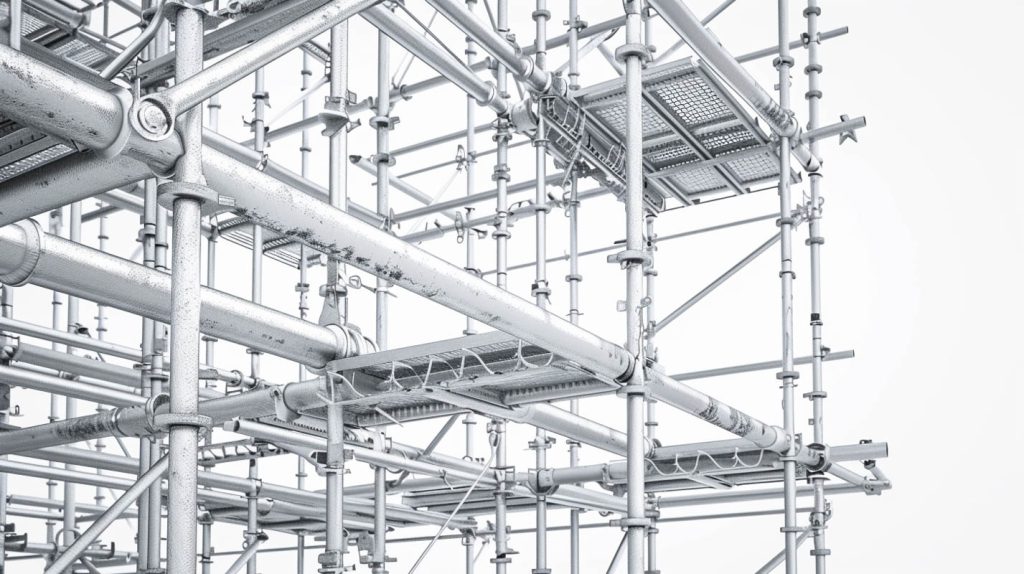
Double scaffolding, or mason’s scaffolding, is preferred for stone masonry due to the difficulty of making holes in stone walls. This type features two rows of standards, which provide extra support. It’s more robust and stable compared to single scaffolding, giving you a safer platform to work on.
Cantilever scaffolding is used when the ground doesn’t support standards, such as when working on busy streets or tall buildings. This type of scaffolding is anchored to the building itself, using needles that are inserted into holes in the wall. It’s crucial you ensure the anchors are secure to prevent any accidents.
Suspended scaffolding, often used for tasks like painting or window cleaning on high-rise buildings, consists of a platform suspended by ropes or chains from the roof, providing a unique scaffolding solution. You can raise or lower this platform as needed, offering you flexibility and ease of access to different building heights.
Understanding these types of scaffolding solutions will help you choose the right one for your specific masonry project, ensuring both safety and efficiency on the job site.
Scaffolding offers numerous benefits that enhance both the safety and efficiency of masonry work. When you’re working on a masonry project, having a stable platform to perform your tasks can make a world of difference. Scaffolding provides that firm footing, allowing you to reach higher areas without straining or risking your balance. This not only speeds up your work but also improves the quality since you can focus solely on the task at hand.
One of the primary advantages of scaffolding is the ease of access it provides. Scaffolding is also critical for fall protection. You won’t have to constantly move ladders or makeshift platforms, which can be both time-consuming and hazardous. With scaffolding, you can cover a larger area without frequent repositioning, making your workflow smoother and more uninterrupted. This efficiency means projects can be completed faster, saving both time and labor costs.
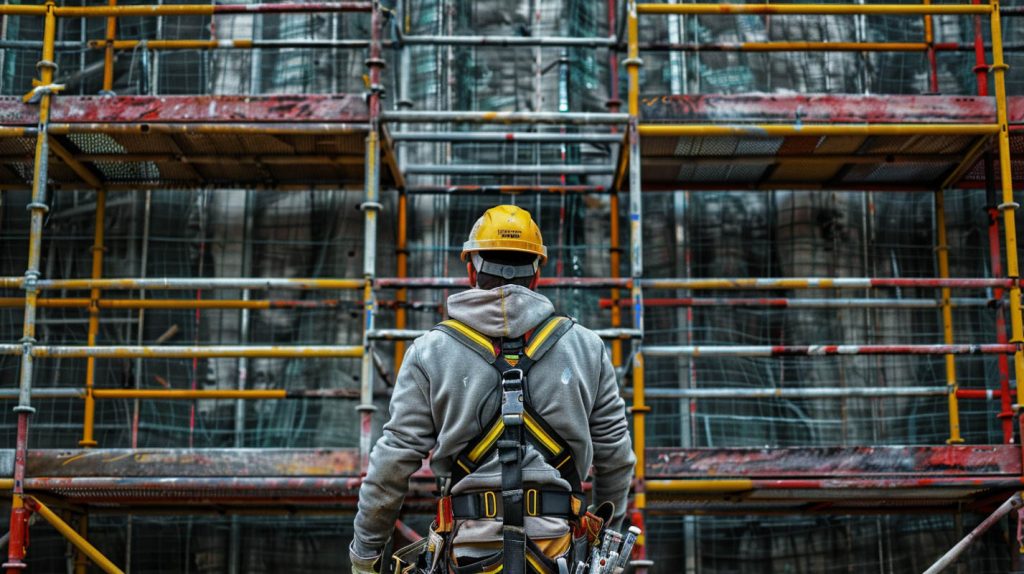
Scaffolding also offers excellent versatility. Depending on the scope and scale of your project, you can choose from various types of scaffolding, such as modular, suspended, or cantilever, to best suit your needs. This adaptability ensures that you have the right tools for any specific requirements, whether you’re working on a small residential repair or a large commercial building.
Another significant benefit is the storage of materials and tools. Scaffolding systems often come with platforms where you can place your equipment, bricks, and mortar, keeping everything within arm’s reach. This reduces the need to climb up and down repeatedly, further enhancing productivity and supporting fall protection measures.
When you’re working with scaffolding for masonry, safety should be your top priority. Make sure you understand proper load limits, secure anchoring practices, and always use personal protective equipment. These measures can prevent accidents and ensure a safe work environment.
To ensure safety, it’s crucial to understand and adhere to the proper load limits specified for masonry scaffolding. Overloading scaffolding can lead to catastrophic failures, putting workers at serious risk. Always refer to the manufacturer’s guidelines and local regulations to determine these limits. Here are some key considerations to help you maintain safe load levels:
Ensuring secure anchoring practices is vital for maintaining the stability and safety of your masonry scaffolding setup. Scaffolding is also crucial for fall protection. First, always check that your anchors are compatible with the type of masonry you’re working with. Not all anchors are suitable for every material, and using the wrong ones can lead to catastrophic failures. Make sure you’re using the correct type and size of anchors specified by the manufacturer.
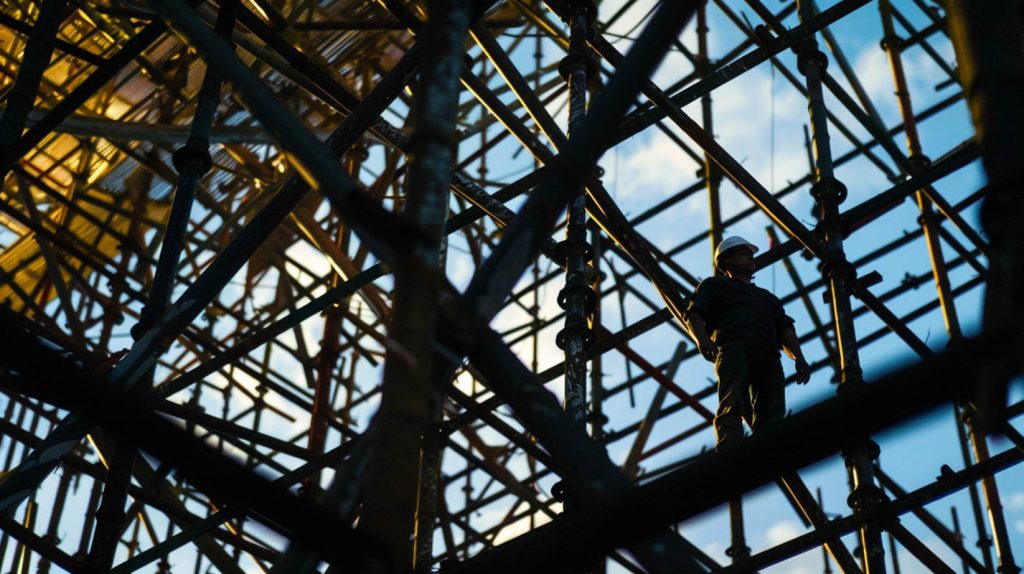
Next, inspect the wall or structure where the scaffolding will be anchored. It should be solid and free of any cracks or weaknesses that could compromise the anchor’s holding power. Drill holes accurately and clean out any debris before inserting the anchors, ensuring the braces are properly positioned. This ensures maximum grip and stability.
Don’t forget to secure the anchors at regular intervals along the scaffolding. Over-relying on a few anchors can create weak points. Follow guidelines on spacing to distribute the load evenly. Lastly, routinely check the anchors during the project. Weather conditions, vibrations, and the weight of materials can cause anchors to loosen over time. Regular inspections can help you catch and address issues before they become serious problems.
Don’t overlook the importance of wearing the right personal protective equipment (PPE) to safeguard against potential hazards on a masonry scaffolding site. It’s easy to skip a step, but doing so puts you at significant risk. Proper PPE is your first line of defense against falling debris, dust, and other dangers.
When you’re working at height, on platforms, or handling heavy materials, the right gear can make all the difference. Here are some essential PPE items you should never be without:
When choosing the right scaffolding system, you’ll need to consider the different types available, each with its own strengths and weaknesses. Don’t forget to factor in safety considerations to ensure a secure work environment. Finally, weigh the cost and efficiency to find the best balance for your project. Go back to Scaffold for Hire Home Page.
Choosing the right type of scaffolding for your masonry project can significantly impact both safety and efficiency. There are several types of scaffolding systems available, each suited for different applications. Understanding their features will help you make an informed decision.
Ensuring safety in your masonry project starts with selecting a scaffolding system that meets both regulatory standards and the specific needs of your work environment. You’ve got to consider the height, load capacity, and specific tasks you’ll be performing. First, check that any scaffolding you’re eyeing complies with OSHA or other relevant safety standards. This isn’t just about ticking boxes; it’s about ensuring that your workers have a safe platform to stand on.
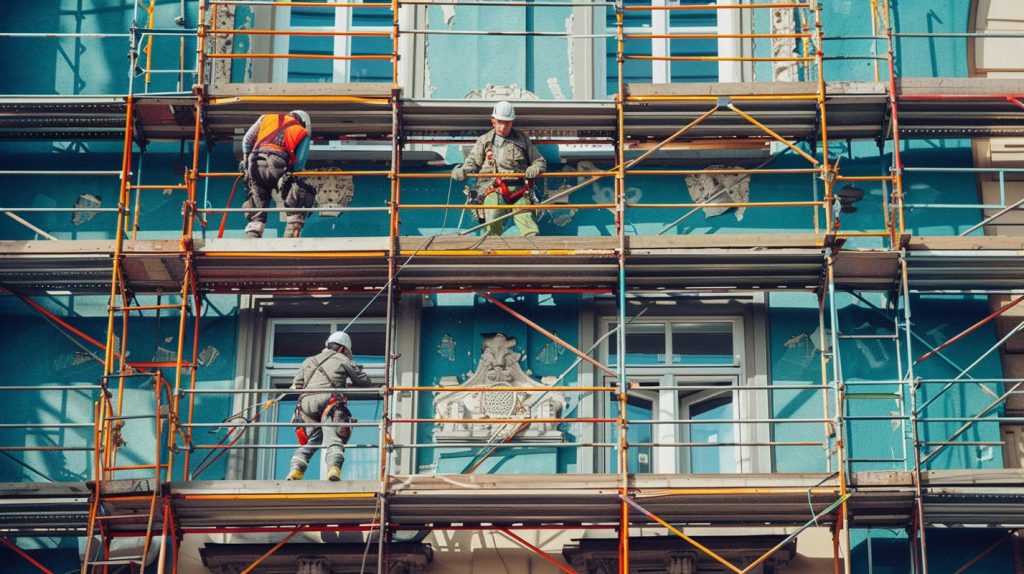
Next, think about the type of scaffolding solutions that best suits your project. Frame scaffolding is great for straightforward, heavy-duty work, while suspended scaffolding might be better for higher elevations and tight spaces. Make sure the system you pick is stable and can handle the weight of your materials and workers without compromising safety.
Don’t forget about the environment. Are you working on uneven ground or a busy site? Adjustable base plates and stabilizers can provide extra security. Additionally, ensure that guardrails, toe boards, and fall arrest systems are part of your setup to prevent accidents.
While prioritizing safety is non-negotiable, balancing cost and efficiency is also key to selecting the right scaffolding system for your masonry project. Choosing the most suitable scaffolding can significantly impact both your budget and project timeline. You’ll need to weigh a few essential factors to ensure you’re making the most cost-effective and efficient choice.
Consider these points when evaluating different scaffolding systems:
When working on residential masonry projects, it’s crucial to select the right type of scaffolding to ensure safety and efficiency. Your choice directly impacts not only the quality of your work but also the well-being of everyone involved. For residential projects, lightweight and easily adjustable scaffolding systems are often the best choice. The primary types you’ll encounter are supported, suspended, and mobile scaffolds. Each has its own strengths and appropriate use cases.
Supported scaffolding is ideal for projects like bricklaying or stonework on the exterior of a house. These scaffolds are stable and can handle the weight of heavy materials, making them a reliable option. They’re also easy to set up and dismantle, which can save you time on smaller projects.
Suspended scaffolding, on the other hand, is useful for tasks that require frequent height adjustments. If you’re working on a taller residential structure, like a multi-story townhouse, this type can be a game-changer. It allows you to move up and down with ease, providing better access to various levels without constant disassembly.
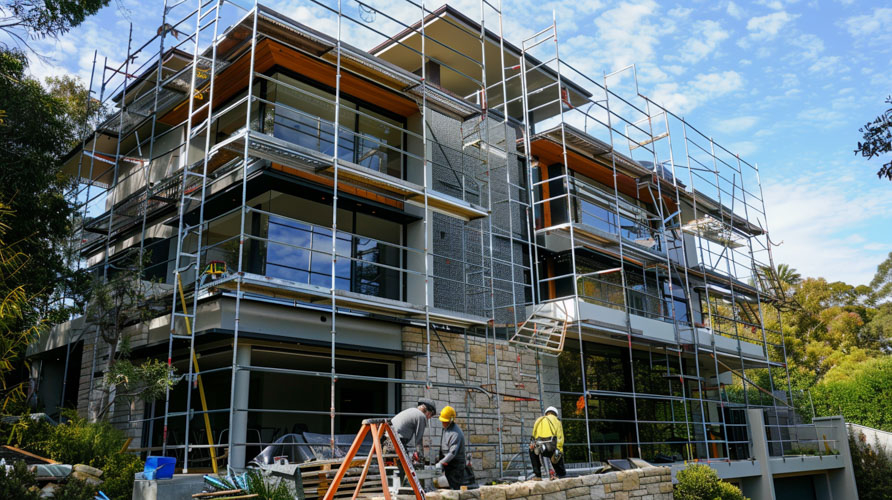
Mobile scaffolding offers flexibility and mobility, perfect for interior masonry work. Think of tasks like repairing a fireplace or installing a stone veneer feature wall. With wheels at the base, you can easily move the scaffold around, making it less cumbersome and more time-efficient.
In residential projects, it’s also essential to consider the working environment. Ensure the ground is level and stable before setting up your scaffolding. Always follow safety guidelines and use guardrails or harnesses when necessary. By choosing the right scaffolding and adhering to safety protocols, you can make your residential masonry project both effective and secure.
For commercial masonry projects, choosing the appropriate scaffolding system is vital for handling larger scales and heavier loads efficiently. When you’re working on commercial buildings, the stakes are higher, and the demands are greater. The right scaffolding system not only ensures safety but also boosts productivity and ease of access to different heights and complex structures.
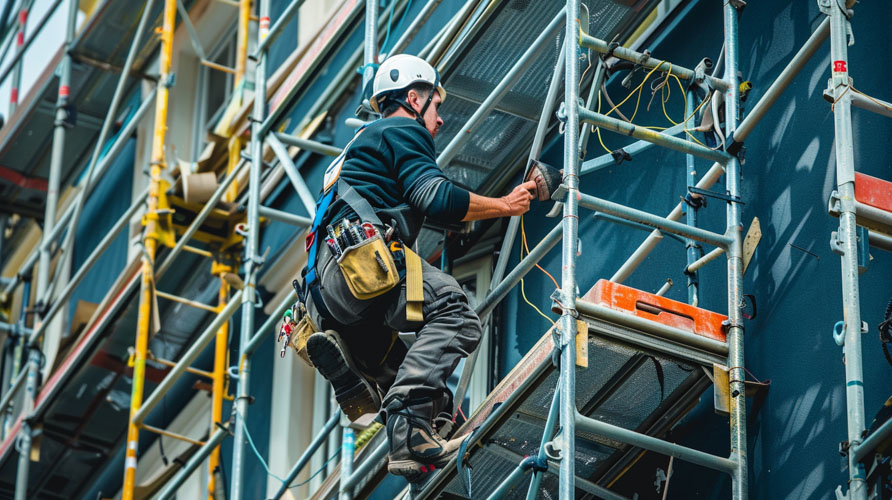
In commercial applications, scaffolding needs to be robust and versatile. You’ll often find that modular scaffolding systems are the go-to choice because they can be customized to fit the project’s specific needs. Here are some key points to consider when selecting scaffolding for commercial masonry:
Using the right scaffolding system can make a significant difference in the efficiency and safety of your commercial masonry project. By considering these factors, you’ll be better equipped to choose a system that meets the unique demands of your job site.
Regular maintenance and thorough inspections are essential to ensure the safety and longevity of your scaffolding system. You’ll need to establish a routine to check for any wear and tear, corrosion, or structural weaknesses on the scaffold boards. Regularly cleaning the scaffolding helps remove debris, dirt, and other materials that can cause damage over time. A clean scaffold is easier to inspect and maintain.
Start by inspecting the scaffolding before and after each use. Look for any visible signs of damage such as bent frames, loose connections, or worn-out components. Pay special attention to the base plates and footings, as these are crucial for stability. If you find any damaged parts, replace or repair them immediately to prevent accidents.
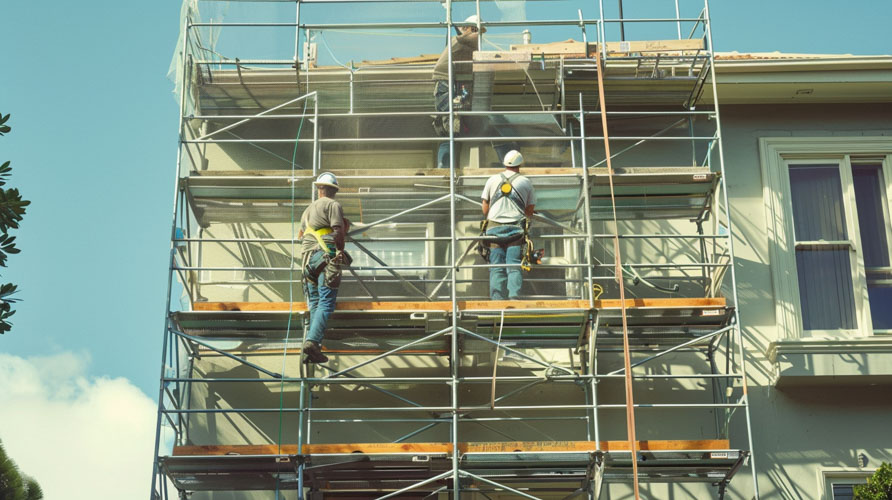
It’s also important to check the scaffolding for proper alignment and ensure that all locking mechanisms and safety features are functioning correctly. Make sure that guardrails, ladders, and access points are secure and in good condition. Regularly tighten bolts and screws to keep the structure firm and stable.
Don’t forget to inspect the planks and platforms. They should be free of cracks, splits, or other signs of deterioration. Wooden planks, especially, can deteriorate faster if not properly maintained.
Additionally, keep a log of your inspections and maintenance activities. This documentation can help track the condition of your scaffolding over time and identify recurring issues that may need more significant intervention.
Ensuring your scaffolding system is well-maintained is just one part of the equation; you also need to consider the costs and budgeting required for purchasing, maintaining, and potentially upgrading your equipment. Proper financial planning can make a significant difference in the long-term viability of your masonry projects.

First, understand that the initial purchase price of scaffolding products isn’t the only cost you’ll face. You’ll need to factor in regular maintenance, occasional repairs, and potential upgrades to your scaffolding system. Budgeting for these expenses in advance can prevent unexpected financial strain.
Here’s a quick breakdown of key costs to consider:
You’re probably wondering about the common materials for scaffolding. Typically, you’ll see aluminum, steel, and wood being used. Aluminum’s lightweight, steel’s super strong, and wood’s quite reliable for smaller projects. Each has its own advantages.
Weather conditions can significantly impact scaffolding stability and the need for proper braces. You’ve got to consider factors like wind, rain, and ice. High winds can topple scaffolding, while rain and ice make surfaces slippery, increasing the risk of accidents.
To work on scaffolding, you’ll need proper training. This includes understanding safety protocols, equipment handling, and emergency procedures. Certification courses and hands-on practice are essential to ensure you’re ready for the job.
Yes, there are regulations governing scaffolding use. You’ll need to follow OSHA guidelines, which cover safety standards, inspections, and training requirements to ensure a safe working environment for everyone involved in scaffold work.
Scaffolding can significantly impact your project timelines. It streamlines worker access, increases safety, and boosts efficiency. However, improper setup or delays in installation can lead to extended timelines and additional costs.